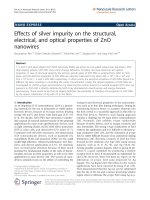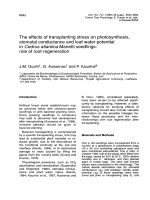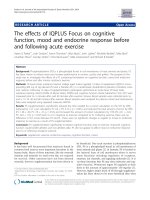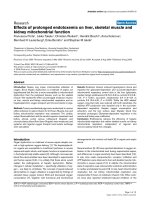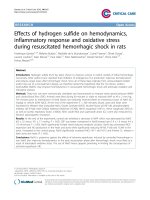Essays in health economics essay i effects of welfare reform on prenatal care utilization and birth outcomes essay II abortion availability and unintended births
Bạn đang xem bản rút gọn của tài liệu. Xem và tải ngay bản đầy đủ của tài liệu tại đây (5.83 MB, 168 trang )
INFORMATION TO USERS
This manuscript has been reproduced from the microfilm master.
UMI films
the text directly from the original or copy submitted. Thus, some thesis and
dissertation copies are in typewriter face, while others may be from any type of
computer printer.
The quality of this reproduction is dependent upon the quality of the
copy submitted. Broken or indistinct print, colored or poor quality illustrations
and photographs, print bleedthrough, substandard margins, and improper
alignment can adversely affect reproduction.
In the unlikely event that the author did not send UMI a complete manuscript
and there are missing pages, these will be noted.
Also, if unauthorized
copyright material had to be removed, a note will indicate the deletion.
Oversize
materials
(e.g.,
maps,
drawings,
charts)
are
reproduced
by
sectioning the original, beginning at the upper left-hand comer and continuing
from left to right in equal sections with small overlaps.
Photographs included in the original manuscript have been reproduced
xerographically in this copy.
Higher quality 6” x 9" black and white
photographic prints are available for any photographs or illustrations appearing
in this copy for an additional charge. Contact UMI directly to order.
ProQuest Information and Learning
300 North Zeeb Road, Ann Arbor, Ml 48106-1346 USA
800-521-0600
R ep ro d u ced with p erm ission o f the copyright ow ner. Further reproduction prohibited w ithout p erm ission.
R e p ro d u c e d w ith p erm is sio n o f th e co p yrig h t o w n e r. F u rth e r re p ro d u ctio n pro hib ited w ith o u t p erm is sio n .
Essays in Health Economics
Essay I: Effects o f W elfare Reform on Prenatal Care Utilization and Birth Outcomes
Essay II: Abortion Availability and Unintended Births
By
Won Chan Lee
A dissertation submitted to the Graduate Faculty in Economics in partial fulfillment of the
requirements for the degree of Doctor of Philosophy, The City University of New York
2001
R ep ro d u ced with p erm ission of th e copyright ow ner. Further reproduction prohibited w ithout p erm ission .
UMI Number: 3 024812
Copyright 2001
by
L ee, W o n Chan
All rights reserved.
UMI
U M I Microform 3 0 2 4 8 1 2
Copyright 2 0 0 2 by Bell & Howell Information and Learning C om pany.
All rights reserved. This microform edition is protected against
unauthorized copying under Title 17, United States Code.
Bell & Howell Information and Learning Com pany
3 0 0 North Z e e b Road
P .O . Box 1346
Ann Arbor, Ml 48 1 0 6 -1 3 4 6
R ep ro d u ced with p erm ission o f the copyright ow ner. Further reproduction prohibited w ithout p erm ission.
ii
©2001
Won Chan Lee
All Rights Reserved
R ep ro d u ced with p erm ission o f the copyright ow ner. Further reproduction prohibited w ithout p erm ission.
A pproval
This manuscript has been read and accepted for the Graduate Faculty in Economics in
satisfaction o f the dissertation requirements for the degree o f Doctor of Philosophy.
mk
Date
Michael Grossman, Chair o f Examining Committee
'! * (
Date
Executive Officer
Tbeodo^Tt5ycp!<3^pervisory Committee
Salih N. Neftci, Supervisory Committee
THE CITY UNIVERSITY OF NEW YORK
R ep ro d u ced with p erm ission o f the copyright ow ner. Further reproduction prohibited w ithout p erm ission.
Abstract
Essays in Health Economics
Essay I: Effects o f W elfare Reform on Prenatal Care Utilization and Birth Outcomes
Essay II: Abortion Availability and Unintended Births
By
Won Chan Lee
Adviser: Distinguished Professor Michael Grossman
This dissertation consists of two papers, not directly related yet both involved
with infants’ well being. The first paper investigates the effects o f welfare reform, a
social change that transformed the United States during the 1990’s, on prenatal care
utilization and birth outcomes. Natality files from 1991 to 1998 were the data set o f this
research. Employing a treatment group-focused multivariate estimation bolstered by a
difference in difference econometrics method, the study found a negative association of
welfare reform both with prenatal care utilization and birth outcomes. The magnitudes
are quite small, yet discem able negative magnitudes are consistently present.
However, “low” intensity reform, which indicates the states that implemented
only “ time lim it,” without other welfare reform components, is associated with enhanced
prenatal care utilization although a negative association obtains between this “ low”
intensity reform and birth outcomes. Among the components o f welfare reform, sanction
and family cap appear to play particularly negative roles in prenatal care utilization and
birth outcomes, while income disregard policy dampens the negative effect.
R ep ro d u ced with p erm ission of th e copyright ow ner. Further reproduction prohibited w ithout p erm ission .
V
The second paper bears on the extent to which the availability o f abortion,
measured by num ber o f abortion providers and distance to nearest abortion provider,
affects the probability o f unintended birth. An association between abortion access
measures and the probability o f unintended/unwanted birth is, albeit not strong, positive,
at the aggregate level. When education and Medicaid receipt are proxied for income and
opportunity cost, these variables interact positively with abortion access measures,
particularly least endogenous variables. These variables tend to increase by 0.8 to 6
percentage points the likelihood that a woman will deliver unwanted babies, relative to
the mean o f 11.7% from 1993 to 1997. The positive association implies that
notwithstanding the presence o f providers, impoverished women will either fail to abort
or fail to use contraception, thereby increasing the probability o f unintended/unwanted
birth.
R ep ro d u ced with p erm ission o f the copyright ow ner. Further reproduction prohibited w ithout p erm ission.
Acknowledgements
There is no such thing as a free lunch; there is no such human being as a completely selfmade man. As with major undertaking, this dissertation could not have m ade the journey
through unfocused ideas to bound pages without the enthusiasm, prodding, and
encouragement o f a wide array o f people.
I owe an immeasurable debt to my dissertation supervisor, Michael Grossman. His
insight and suggestions as an economist have never ceased to surprise me. As a hum an
being, his evenhandedness and compassion are unsurpassed. I am equally indebted to
Theodore Joyce and Robert Kaestner.
suggestions and guidelines have been ju st as
valuable, and I feel grateful for the concern that they showed during the difficult tim e that
I encountered. They allowed me to use NBER office space, a window o f opportunity for
the contact and the exchange of ideas with many stellar people.
M y life would have not known a turnaround without the encouragement and suggestions
o f Linda Edwards. I met her when I came in New York in 1997 as an exchange program
student from Paris. While working as her research assistant and ever since, I have found
her encouragement particularly kind and helpful. M uch appreciation is due to Thomas
Thurston for helping me focus my energies and broaden my horizons. M any thanks go to
the Graduate Center o f the City University o f New York for the award that enabled me to
pursue the completion o f my dissertation without financial burden.
M y parents have given me constant support, both emotional and financial, and to them I
dedicate this dissertation. I thank them for their unconditional love, and I feel grateful to
the many friends who have been supportive o f me during many difficult moments.
R ep ro d u ced with p erm ission o f the copyright ow ner. Further reproduction prohibited w ithout p erm ission.
Table of Contents
Essay I: Effects o f W elfare Reform on Prenatal Care Utilization and Infant Birth
Outcomes.
Page
Introduction
1
A Decline in M edicaid Enrollment
4
Channels o f W elfare Reform Affecting Health Outcomes
5
Purpose o f the Study
7
M ajor Components o f W elfare Reform
7
Analytical Framework
11
Previous Research
15
Data
18
Empirical Methods
19
Empirical Results
25
1) Time Trend and Summary Statistics
2) Model Description
3) Econometric Results: M uch Ado about Very Little
A.
Treatment Group Estimation
a) Effects o f W elfare Reform on Prenatal Care Utilization
b) Effects o f W elfare Reform on Birth Outcomes
c) Black and W hite Separate Regression
d) Effects o f State Unemployment on Prenatal Care Utilization
and Birth Outcomes
e) Discussion o f Other Individual Characteristics
f) Different M odel Specifications
g) Com parison between Linear Probability Ivlodei and Logit M oaei
25
26
29
29
29
32
33
34
34
34
35
R ep ro d u ced with p erm ission o f the copyright ow ner. Further reproduction prohibited w ithout p erm ission.
h) “Low” and “ High” Intensity Reform
i) Separate Regression for Blacks and Whites
36
37
B. Impact o f Welfare Reform on M arital Status
38
C. Difference in Difference Estimation
40
Conclusion
Essay II: Abortion Availability and Unintended Births
Page
Introduction
74
Purpose o f the Study
75
Literature Review
80
Data
84
Abortion Rates, Abortion Access M easures and Unintended Births
86
Economic Model
89
Econometric Model Description
95
Empirical Study
99
1) Summary Statistics
2) Econometric Results
99
99
A. The Aggregated Regression
99
B. Interaction with Education Level
103
C. Interaction with M edicaid Recipients
108
D. The effects o f Abortion Rates on the Probability
o f Unintended/Unwanted birth
110
D. Effects o f Abortion Access on Abortion Rate at the State Level
110
Conclusion
114
R ep ro d u ced with p erm ission o f the copyright ow ner. Further reproduction prohibited w ithout p erm ission.
List of Tables
Essay I: Effects of W elfare Reform on Prenatal Care Utilization and Birth Outcomes
Page
Table 1
Descriptive Statistics
(Below 12 Years o f Educational Attainment by Race from 1991 to1997)
44
Table 2
Medicaid Eligibility Thresholds for 10 biggest states
45
Table 3
The Effects o f W elfare Reform on Third Trimester Prenatal care
(Unmarried and under 12 years o f educational attainment)
46
The Effects o f Welfare Reform on First Trimester Prenatal care
(Unmarried and under 12 years o f educational attainment)
47
The Effects o f Welfare Reform on Number o f Prenatal Care Visit
(Unmarried and under 12 years of educational attainment)
48
Table 4
Table 5
Table 6 The Effects o f Welfare Reform on No Prenatal care
(Unmarried and under 12 years of educational attainment)
49
Table 7 The Effects o f Welfare Reform on Low Birth W eight
(Unmarried and under 12 years o f educational attainment)
50
Table 8
The Effects of W elfare Reform on Very Low Birth Weight
(Unmarried and under 12 years o f educational attainment)
51
The Effects o f Welfare Reform on Log Birth W eight
(Unmarried and under 12 years o f educational attainment)
52
Table 10 Different Model Specifications
(Unmarried and under 12 years o f educational attainment)
53
Table 11 Comparison between Linear Probability Model Coefficients
and Logit Model Marginal Effects
(Unmarried and under 12 years of educational attainment)
54
Table 12 Low Intensity Reform and High Intensity Reform
(Unmarried and under 12 years of educational attainment)
55
Table 13 Racial Comparison: Effects o f Welfare Reform on Third Trim ester
Prenatal Care (Unmarried and under 12 years o f educational attainment)
56
Table 9
with p erm ission of the copyright ow ner. Further reproduction prohibited w ithout p erm ission .
X
Page
Table 14 Racial Comparison: Effects of W elfare Reform on First Trimester
Prenatal care (Unmarried and under 12 years o f educational attainment)
57
Table 15 Racial Comparison: Effects o f Welfare Reform on Number o f Prenatal Care
(Unmarried and under 12 years of educational attainment)
58
Table 16 Racial Comparison: Effects of Welfare Reform on No Prenatal care
(Unmarried and under 12 years of educational attainment)
59
Table 17 Racial Comparison: Effects of Welfare Reform on Low Birth W eight
(Unmarried and under 12 years of educational attainment)
60
Table 18 Racial Comparison: Effects o f Welfare Reform on Very Low Birth W eight
(Unmarried and under 12 years o f educational attainment)
61
Table 19 Racial Comparison: Effects of Welfare Reform on Log Birth W eight
(Unmarried and under 12 years of educational attainment)
62
Table 20 The Effects o f Welfare Reform on M arital Status
63
Table 21 Difference and Difference Estimation for the “ W elfare Reform,”
the “ Low” Intensity, and the “ High” Intensity Reform
(Unmarried and under 12 years of educational attainment for
Treatment Group, Married and under 12 years o f educational attainment
for Control Group)
64
Essay II: Abortion Availability and Unintended Births
Table 1 Summary Statistics from 1993 to 1996
115
Table 2
States and Years Participating in the PRAM S Project
116
Table 3
NCHS Total Births
116
Table 4
PRAMS Total Births
117
Table 5 Abortion Accessibility Measures from 1988 to 1997
118
Table 6
119
Distance Barriers to Abortion Providers
R ep ro d u ced with p erm ission o f th e copyright ow ner. Further reproduction prohibited w ithout p erm ission .
Page
119
Table 7
Abortion Access Measures Used in Regression Analysis
Table 8
The Effect o f a Dummy Variable for a County with at least One Abortion
Provider on the Probability o f Unintended Births, 1933-1997
120
Table 9
The Effect o f Number o f Large Non Hospital Providers per 100,000
Women on the Probability o f Unintended Births, 1933-1997
121
Table 10 The Effects o f Abortion Access Measures on the Probability
o f Unintended Births, 1933-1997
122
Table 11 The Effects o f Abortion Access Measures on the Probability
o f Unintended Births, 1933-1997
123
Table 12 The Effects o f Abortion Access Measures on the Probability
ofU nintended Births, 1933-1997
(Educational Attainment Interaction with Abortion Access)
124
Table 13 The Effects o f Abortion Access Measures on the Probability
ofU nw anted Births, 1933-1997
(Educational Attainment Interaction with Abortion Access)
126
Table 14 The Effects o f Abortion Access Measures on the Probability
ofU nintended Births, 1933-1997
(Medicaid Recipients Interaction with Abortion Access)
128
Table 15 The Effects o f Abortion Access Measures on the Probability
ofU nw anted Births, 1933-1997
(Medicaid Recipients Interaction with Abortion Access)
130
Table 16 The Effects o f Abortion Access on Abortion Rate,
1993-1996 for All States.
132
Table 17 The Effects o f Abortion Access on Abortion Rate,
198S-1996 for All States.
133
Table 18 The Effects o f Abortion Access on Abortion Rate,
1993-1996 for PRAMS 10 States.
134
Table 19 The Effects o f Abortion Rate on the Probability ofU nintended Births,
1993-1997
135
Table 20 The Effects o f Abortion Rate on the Probability ofU nw anted Births,
1993-1997
136
R ep ro d u ced with p erm ission o f the copyright ow ner. Further reproduction prohibited w ithout p erm ission.
Page
Table 21 The Effects of Abortion Rate on the Probability ofU nintended Births,
1993 -1 9 9 7 (Fewer than 12 years Educational Attainment)
137
Table 22 The Effects o f Abortion Rate on the Probability ofU nw anted Births,
1993 -1 9 9 7 (Fewer than 12 years Educational Attainment)
138
R ep ro d u ced with p erm ission o f the copyright ow ner. Further reproduction prohibited w ithout p erm ission.
List of Graphs
Essay I: Effects o f Welfare Reform on Prenatal Care Utilization and Birth Outcomes
Page
Graph 1: AFDC/TANF Percentage o f Total U.S. Population (1991-2000)
65
Graph 2: Out-of-W edlock Birth Rates (1980-1997)
66
Graph 3: Out-of-W edlock Birth Rates by Race (1980-1997)
67
Graph 4: Proportion o f Births to Unmarried W omen
68
Graph 4: Tim e Trend for the Percentage o f Late Prenatal Care Visit (1991-1998) 69
Graph 5: Tim e Trend for the Percentage o f No Prenatal Care Visit (1991-1998)
70
Graph 6: Tim e Trend for the Percentage o f Low Birth Weight (1991-1998)
71
Graph 7: Time Trend for the Percentage o f M ultiple Births (1991-1998)
72
Essay II: Abortion Availability and Unintended Births
Page
Graph 1: Tim e Trend o f Proportion ofU nintended, Unwanted and M istimed Births
out o f Total Births.
139
Graph 2: NCHS and PRAMS Total Births
140
Graph 3: CDC Abortion Rate and PRAMS Abortion Rate
141
Graph 4: Number o f Abortion Providers
142
Graph 5: Proportion o f Women Living in a County with at Least one Provider
143
Graph 6: Number o f Abortion Providers per 100,000 Women in a County
144
Graph 7: Number o f Non Hospital Abortion Providers
per 100,000 Women in a County.
145
with p erm ission of th e copyright ow ner. Further reproduction prohibited w ithout p erm ission .
1
Introduction
Public policy toward the disadvantaged has shifted dramatically in recent years.
The m ajor change is that social programs are putting more emphasis on personal rather
than social responsibility. Reflecting this social trend, welfare reform is intended to
reduce fam ilies’ dependence on government financial support by encouraging
employment and changing behaviors related to marriage and fertility.1 Judging by
changes in caseloads nationally, welfare reform has been a success. Between January
1994 and December 1999, welfare caseloads fell 53 percent.
Though national legislation was passed in August 1996 (the Personal
Responsibility and W ork Opportunities Reconciliation Act— PRWORA), a num ber o f
states had already begun reforming welfare in the early nineties. Welfare caseloads
started to decline soon thereafter. Although the pace was modest at first, welfare rolls fell
faster as more states adopted reform. After federal legislation was passed, caseloads
declined even more precipitously. Between January 1997 and December 1999, 1.8
m illion families left the welfare rolls, almost double the num ber that moved o ff welfare
in the three years prior to that period. In 1994, 5.5 percent o f the US population was
dependent on welfare. Five years and a series o f state and federal welfare reforms later,
the proportion had shrunk to 2.3 percent (Graph 1).
1 “The Findings” section of The Personal Responsibility and Work Opportunity Reconciliation
Act of 1996 (PRWORA) concludes: “ Therefore, in light of this demonstration of the crisis in our
nation, it is the sense of the Congress that prevention of out-of-wedlock birth is a very important
government interest and the Policy contained in part A of Title IV of the Social Security A c t . . . .
is intended to address the crisis. Out-of-wedlock births reduce a woman’s ability to remain
financially independent and to raise children in a healthy and secure environment.” Indeed, under
the “Illegitimacy Bonus” program, the Federal government awards S20 million each year to the 5
states that most reduce their out-of-wedlock birth rate.
R ep ro d u ced with p erm ission o f the copyright ow ner. Further reproduction prohibited w ithout p erm ission.
The shrinking number o f welfare recipients has raised concerns about the plight of
poor single mothers and their dependent children, the main beneficiaries o f welfare or
what is now called Temporary Aid to Needy Families (TANF). Since the passage o f state
and federal welfare reform legislation, numerous researchers have studied the
employment status and earnings o f women who have left the AFDC/TANF rolls (Schoeni
and Blank, 2000). Some have analyzed the reasons for the marked decline in caseloads
since the mid 1990s (Grogger, 2000)). The effects o f welfare reform, however, need not
be restricted to declines in caseloads and changes in employment. There may be
unintended consequences associated with the transition from welfare to work and the
greater labor market activity it entails.
Welfare reform m ay lead to a loss o f health insurance, greater work-related stress,
changes in a w om an’s self-esteem, and changes in family income. All o f these changes
m ay affect the health and health-care utilization o f poor women and infants, and some
changes are expected to adversely affect these outcomes.
Unlike most developed countries, the United States has an unusually high level of
infant mortality (7.2 per 1000 live births in 1997) coupled with a high rate o f relatively
low birth weight, factors which are considered an objective measure o f birth outcomes.
Moreover, variations in birth weight seem to coincide with socioeconomic factors—
women with more resources and greater access to healthcare are consistently having
healthier children (M orbidity and M ortality W eekly Report, 2000).2 Not only was it clear
‘ MMWR (2000) reports that black infants are more than twice as likely to die as white infants;
this ratio has increased in recent decades. The higher risk for infant mortality among blacks
compared with whites is attributed to higher preterm rate and iow birth weight incidence.
R ep ro d u ced with p erm ission o f the copyright ow ner. Further reproduction prohibited w ithout p erm ission.
that not all women in the U.S. were receiving the same quantity or quality o f healthcare
as wom en in other developed countries; there were significant differences across classes
in this country as well.
In the political arena, the debate over how to address this problem has been split
into two camps. Some policy makers view low birth outcomes as a result o f individual
failure, pinning the problem on the personal health habits o f pregnant women and out-ofwedlock mothers (Rosenzweig and Wolpin 1991, Evans 1999).3 In the 1980s, a rise in
cocaine use and the increasing rate o f teenage births were also viewed as contributing to
low birth outcomes. For some, the conclusion was plain— only individual efforts by
pregnant wom en could have an impact on infant health.
Others argued that financial barriers prevented poor and near-poor women from
receiving timely and high quality prenatal care. W hatever their individual health habits,
these women experienced adverse birth outcomes due to inadequate or inaccessible
health care. Following this line o f thinking to its logical end, it seem ed clear that the lack
o f insurance among the poor and near poor was the main cause o f unfavorable birth
outcomes. Despite vehement arguments on both sides, the problem was ultimately
viewed as a social one, and policy makers adopted legislation governing expansion o f
M edicaid eligibility, opening up health care to a new segment o f the underserved
population.
3 It has been proved that smoking during pregnancy lowers birth weight. Rosenzweig and Wolpin
(1991) employed the analysis of variances, and they concluded that eliminating smoking among
all pregnant women would increase the average birth weight of first boms by 1.2 ounces. In
Sexton and Hebei’s clinical trial (1984), the treatment group was 92 grams higher in birth weight
than the control. Employing cigarette taxes as an instrument of smoking vanable m birth
production function, Evans and Ringel (1999) obtained a smoking effect of the same magnitude.
R ep ro d u ced with p erm ission o f the copyright ow ner. Further reproduction prohibited w ithout p erm ission.
4
Accordingly, the late 1980’s and early 1990’s were marked by a rapid expansion
in M edicaid eligibility and enrollment for pregnant women, infants, and children. The
series o f legislative reforms on M edicaid eligibility was intended to serve as a vehicle to
increase infant health. The percentage o f births financed by M edicaid rose from 21% in
1988 to 48% in 1992, and it has remained relatively stable since 1992 (.Maternal Child
Health Update, 1988-1992). At the same time, the enrollment o f children in M edicaid
increased from 10.3 million to 17.1 million between 1989 and 1995, a rise o f 15
percentage points (Newacheck et al., 1998). More recently, the State Children Health
Insurance Program (SCHIP) was created to increase the enrollment o f near-poor children
in publicly funded health insurance.
O f widespread concern, however, has been that welfare reform, which culminated
in the 1996 Personal Responsibility and Work Opportunity Reconciliation Act
(PRW ORA), may undo the gains associated with the M edicaid expansions. The
significant declines in welfare caseloads may have resulted in a greater number of
uninsured.
A Possible Decline in M edicaid Enrollment
Established in 1965, M edicaid is the largest single spending program in the
United States assisting the poor and nearly poor. Eligibility to receive M edicaid is
determined by the states, but the federal government requires that pregnant women and
infants in families with income below 133 percent o f the official poverty threshold m ust
be mandatorily eligible. M edicaid is not automatic for families who receive TANF cash
assistance as it was under the old AFDC program, although TANF recipients are eligible
R ep ro d u ced with p erm ission o f the copyright ow ner. Further reproduction prohibited w ithout p erm ission .
5
in most states. M ost M edicaid recipients must have income and assets below specified
amounts. These amounts vary from state to state but are determined w ithin federal
guidelines.
According to M aternal and Child Health Update (1999), M edicaid paid for
approximately 1 m illion births in 1997. The MCH U pdate indicates that the majority of
states reported fewer Medicaid births in 1997 than in 1996. Medicaid births as a
percentage o f total births in each state ranged from a high o f 51 percent in New Mexico
to a low o f 20 percent in New Hampshire. The m edian percentage o f M edicaid births was
33 percent in 1997, compared with 38 percent in 1996, an indicative finding that pregnant
women may have lost public insurance.
Channels of W elfare Reform Affecting Health Outcom es
W elfare reform may have triggered a decrease in the Medicaid enrollment o f
pregnant wom en and infants. Welfare reform may alter insurance status in two ways.
First, increased labor force participation induced by welfare reform m ay make more
women, infants and children ineligible for Medicaid. Second, the uncoupling o f
Medicaid and cash assistance may make M edicaid enrollment more difficult to obtain
(Chavkin et al. 1999). On the other hand, greater labor market activity m ay increase the
incidence o f private insurance coverage among poor families.
Such a change in insurance status may alter health care utilization. W elfare
reform may also directly affect health care utilization without a significant change in
insurance status. If changes in health care utilization had an effect on infant health, then
welfare reform could have a deleterious impact on infant health (A lexander and
R ep ro d u ced with p erm ission o f the copyright ow ner. Further reproduction prohibited w ithout p erm ission.
6
Korenbrot, 1995). W hen insurance status is held constant, time constraints and logistical
barriers will cause delays in prenatal care or a decrease in prenatal care visits. W elfare
reform may also affect health outcomes through mechanisms other than its effects on
insurance status and health care utilization. Examples include stress levels and time
constraints as well as sleep, diet, and smoking patterns. W omen induced to work by
TANF are, like other low-wage workers, likely to perform physically demanding jobs.
Shifts in the average physical and mental activity level o f women o f child-bearing age
may elevate their stress level and thus cause a higher rate o f smoking and an increase in
other stress-reducing behaviors that are detrimental to health. Indeed, Rosenzweig and
Schultz (1983) found that mothers appear to smoke less where female unemployment
rates are high. W elfare reform might lower infant health if smoking and labor force
participation were complements. Because women would also face more severe time
constraints and logistical barriers, direct investment in health inputs such as proper diet
and sleep may have been reduced. These various channels can be summarized in the
following chart. For welfare reform to affect birth outcomes, it should be a causal link in
this chain.
Various Channels Affecting Birth Outcomes
W elfare reform -> Changes in Insurance Status -> Changes in Prenatal Care -> Infant
Birth Outcomes
W elfare reform -> Changes in Prenatal Care -> Infant Birth Outcomes
Welfare reform
Infant Birth Outcomes
R ep ro d u ced with p erm ission o f th e copyright ow ner. Further reproduction prohibited w ithout p erm ission .
7
Purpose of the Study
This study investigates the effects o f state and federal welfare reform on the
health care utilization and health outcomes o f pregnant wom en and infants. Several
specific questions arise. First, has welfare reform increased the number o f women who
delay or reduce prenatal care visits, and if so, has it resulted in worse infant health
outcomes? In other words, are birth outcomes and use o f maternal prenatal care
responsive to welfare reform? Second, if welfare reform m ay have adverse consequences
for birth outcomes, my study attempts to identify how that causality operates. Third, I
examine whether w elfare reform has affected marriage rates among wom en who gave
birth. While not a health outcome, non-marital fertility is a central concern o f welfare
reform and one that has received relatively little study. I include the study o f this issue in
my research because, as I describe below, it is a necessary step toward a better
understanding o f the central questions I have posed.
Ma jor Components of W elfare Reform
In the decade preceding welfare reform in 1996, states had already begun to
experiment with shifts in their state regulations governing welfare policy under federal
authorization.4 These granted modifications o f state policy are commonly referred to as
waivers. Between January 1993 and August 1996, the Departm ent o f Health and Human
Services approved welfare waivers in 43 states. Som e o f these waivers supported modest
4 The U.S. department of Health and Human Services maintains a web site
( providing information by state on
the timing of major changes to welfare policies under both the AFDC program (1992-1996) and
the TANF program (1996-1998).
R ep ro d u ced with p erm ission o f the copyright ow ner. Further reproduction prohibited w ithout p erm ission.
8
demonstration projects limited to a few counties, but many states instituted statewide
m odifications o f the AFDC program. These waivers bear on five general welfare policies:
tim e limits, sanctions, income disregard, Fam ily Cap, and work exemption.
Under AFDC requirements, recipients were, unless exempt, required to participate
in the Job Opportunity and Basic Skills Training (JOBS) program that provided
education, training, and work experience activities. However, the exemption categories
were claimed to be overly broad. As a result, recipients tended to be, more often than not,
exem pt from the JOBS program. This lax requirem ent prompted some states to obtain
autonomous control o f the JOBS program, making it mandatory for a greater num ber o f
AFDC recipients. A particular concern for my study is that waivers reduced the
exemptions for pregnant women to exclude all but those with medical reasons. Further,
states were allowed to implement sanctions for non-compliance with JOBS. For example,
23 states received waivers that allowed them to impose full-family sanctions (i.e,
term ination o f fam ilies’ AFDC grant).
More dramatic change concerns the duration o f benefits that welfare recipients
m ay receive. U nder AFDC rules, families were entitled to receive assistance for as long
as they met the eligibility standards. However, through waivers, the Federal government
began to allow states to set time limits on welfare entitlement. By and large, three types
o f time limits can be categorized under this waiver. These time limits include the
“Termination Tim e Limit,” the “W ork Requirement Time Limit,” and the “Reduction
Tim e Limit.” The “Termination Tim e Limit” denies further AFDC benefits once families
have used up their allotted limit. The “ Work Requirement Time Limit” imposes a
m andatory work requirement but does not cut o ff the benefits. The “Reduction Time
R ep ro d u ced with p erm ission o f the copyright ow ner. Further reproduction prohibited w ithout p erm ission.
9
Lim it” reduces the benefits after families have been on welfare for a certain period o f
time.
Another feature o f welfare reform is called the “ Family Cap.” The
implem entation o f this waiver policy hinges on the argument that AFDC rules may create
an incentive for welfare recipients to have more children in order to receive a larger grant
am ount (Jackson and Klerman, 1994; Matthews, Ridar and Wilhelm 1997). Jackson and
Klerm an (1994) found that AFDC benefits had large positive effects on the birthrate
among white wom en but no association among blacks. A simple reason is that the total
amount that a family m ay request is based on family size. This argument permitted some
states to implement “Fam ily Cap” waivers. These waivers eliminate or reduce the
increase in benefits upon the birth o f an additional child following the fam ily’s initial
reception o f AFDC.
Under AFDC rules, all recipients who worked were entitled to a S90 work
expense disregard. In addition, for the first four m onths o f AFDC receipt, the next S30 of
earned income, plus one-third of the remainder, was disregarded in calculating eligibility
and benefits. M any states came to the conclusion that the term ination o f the earned
income disregard after a short period removed the economic incentive for AFDC
recipients to work. Therefore, some states removed the time limit on the S30 and onethird disregard, or even disregarded all income up to the poverty line.
The effect o f the “ Family Cap” on infant birth outcomes is not easily predictable.
N either is the effect o f the various time limits. If the “Family Cap” indeed influences
fertility and thus reduces the number of children, it may have a positive impact on infant
health since parents allocate both their time and income more intensively to the selected
R ep ro d u ced with p erm ission o f the copyright ow ner. Further reproduction prohibited w ithout p erm ission.
